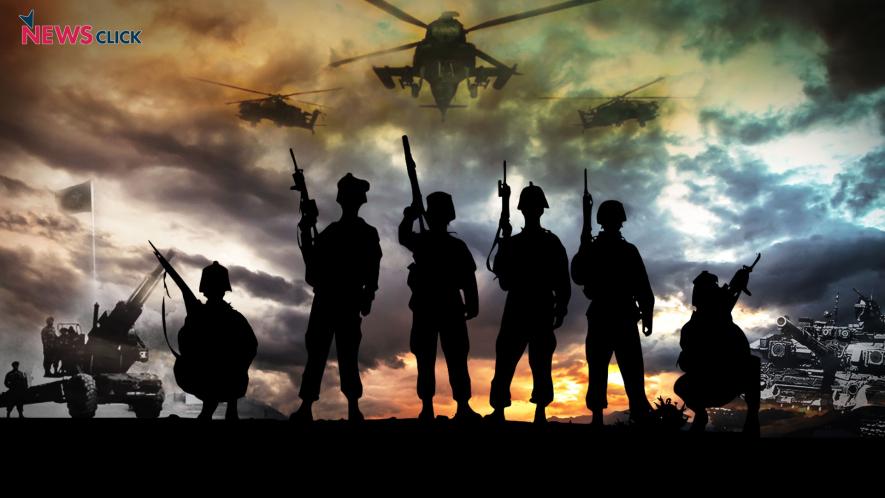Military Budget: A Pre-Budget Analysis

Newsclick Image by Nitesh Kumar
It has by now become part of conventional wisdom to lament the inadequate allocation of funds for India’s military sector and to claim that 2.5% to 3% of the GDP ought to be set aside for defence to meet the threat scenario.
So, as we get closer to Budget 2018-19, there is a cacophony of pre-Budget analysis bemoaning the lack of adequate funds for military equipment acquisitions.
As a matter of fact, there can be no doctrinaire prescription of a certain percentage of the GDP to be set aside for military sector, because allocations are determined by the threat scenario and perception and not by percentage of the GDP.
For instance, if the country’s strategic policy is geared to prepare for the “most likely scenario” rather than the “worst case scenario”, it could mean policymakers shedding the strategy to face a ‘two-front war’ because a conventional war is ruled out, replaced by threat of localised border conflict. This makes for a major shift, because if a “two-front war” scenario is ruled out, this will negate the need for the Indian Air Force to raise 42 air squadrons needed for a two-front war scenario, and it also brings down the need for maintaining a huge force for conventional warfare, when the likelihood of conventional war itself is much reduced. So between acknowledging obliquely the presence of a problem, expansion of force and the revenue burden cast by it in shape of pay, allowances and pension, and doing something about it, many a question rears its head.
For instance, why is it that there has been a jump of nearly 40% in transgressions by China, rising from 271 in 2016 to 415 and the number of areas of major disputes has risen from just two in 1995 to 23 in 2017. The surge in transgressions has happened since the BJP-RSS government came to power. A similar surge in ceasefire violations with Pakistan along LoC rising from 152 violations in 2015, 228 in 2016 and 820 in 2017 reveals that a muscular approach is deliberately being followed.
The Army Chief on 12 January opined that in order to cause “pain” to Pakistan, the Indian Army is now targetting Pakistani military posts causing “3-4 times more casualties.” Such approaches are tailor-made to exacerbate tensions and risk escalation of military conflict. So whose interest is it serving?
Secondly, contrary to “experts” or even the Parliament Standing Committee on Defence, India has been allocating between 2.25% to 2.5% of its GDP for defence. For instance, when “experts” state that the defence budget in FY 2017-18 was merely Rs 2,74, 114 cr or 1.72% of the GDP, they arrive at this figure by excluding the Defence Pension from consideration, even though pensions are ‘deferred wages’ and are part of military’s manpower costs. It was in 1988 that the Indian budget planners de-coupled pensions for military personnel from defence budget. If this is taken into account, then the defence budget goes up to Rs 3,59,854 crore and is more than 2.2% of the GDP.
The US spent $654 billion in 2017 and China $152 billion, however, in terms of percentage of the GDP, whereas the US spent more than 3.5 % of its GDP, for China it is less than 1.9% of its GDP.
Even more interesting is the fact that Saudi Arabia spends more than 10% and Israel in excess of 5% of their GDP. In other words, the countries spending more in terms of percentage of the GDP show a propensity for military adventurism and are hardly worth emulating.
More significantly, practically every year India’s Ministry of Defence surrenders nearly 8-10% of its capital allocations. Thus in 2016-17, the Ministry’s Rs 6,886 crore remained underutilised, and it would be of interest to see what percentage of the capital budget remained underutilised.
Besides, a fairly large portion of the defence budget is consumed by wars at home in which Indian Army is engaged and which keeps more than 500,000 soldiers deployed in the North East and in Jammu & Kashmir. So what portion of the defence budget is consumed by?
If manpower costs make up more than 50% of the defence budget, then surely deployment of 500,000 military personnel year after year, decade after decade, in these wars at home must carry a cost. Just the manpower costs for deploying 500,000 soldiers would mean an approximate figure of 30-35 % of the wage and pension bill.
So is there any re-thinking on war-making at home against our own people?
Recall that Ministry of Home Affairs has also called for parity between Services and Central Armed Police Forces because it is claimed they carry out the same tasks.
So, if indeed finances are an issue, it makes no sense to tell the Services to be lean, while carrying on with keeping the CAPFs bloated.
It makes one wonder as to why India’s rulers are so shy about giving up on waging war against our own people?
Quite apart from the dividend which democratic solution offers, in the shape of freeing fellow citizens from all kinds of encumbrances which shackle them, it can actually free funds now tied in needless war, for better use elsewhere.
However, the interesting thing to note is that there is a shortage of 60,000 personnel in Armed Forces — with the Army short of 27,864 personnel, of which officer shortage accounts for 7694; Navy short by 16,235 personnel; and the Air Force 15,503 by personnel.
The Navy’s shortfall is nearly 25% of its sanctioned strength of 67,228, Air Force 10% of its sanctioned strength of 150,000 and Army 2.2% of its 1.4 million personnel.
For the Army, it is the 16% shortage of officer cadre out of the sanctioned strength of 49,932 that stands out.
What is worth noticing is that India’s Naval chief boasted on Navy Day in December last year that the Navy is deployed 24X7 from the Indian Ocean to the Western Pacific. But such deployment merits scrutiny because naval ships have shown a tendency to be accident-prone.
This compounds the problems facing the Navy because in the headlong rush for ‘Make in India’, i.e. foreign Original Equipment Manufacturers, encouraged to invest and build in India, sanction has not been given for building six submarines by the public sector naval dockyard.
A common argument of proponents of the private sector is that the defence public sector units (DPSUs) have shown themselves to be incapable of meeting the country’s military needs.
But any shortcomings of DPSUs should not hide the fact that private sector is wasteful in far more damaging ways, because it is guided by profit-making.
In contrast, DPSU’s alone can sustain “idle infrastructure” and the skilled work force, if there are no contracts. In other words, will the government compensate OEMs for “idle capacity”?
Military is a sector where there is one buyer and several suppliers. While private suppliers will be keen to corner more and more funds, the goals of PSUs are vastly different in that it is indigenous development, not profit, that guides them.
Therefore, as we wait for the 2018-19 Budget proposals, what is worth keeping in mind is that the country’s scarce resources are not frittered away for whipping up conflict with China and Pakistan.
A good place to start is to put the threat perception and scenario to scrutiny and analysis to see whether it serves our people’s interests and the country’s independent foreign policy. Those who whip up fears over China’s rise and its alleged “unwillingness” to consult and take into account the concerns of other countries are not only promoting the interests of the US and its client states, they deliberately distort history when they play down the unilateralist and reckless policies of the US and its allies for more than a century riding roughshod over other countries and people.
It is such fraudulent perceptions, which need to be interrogated, because they peddle myths which justify the muscular approach and wasteful military expenditure.
Get the latest reports & analysis with people's perspective on Protests, movements & deep analytical videos, discussions of the current affairs in your Telegram app. Subscribe to NewsClick's Telegram channel & get Real-Time updates on stories, as they get published on our website.
























